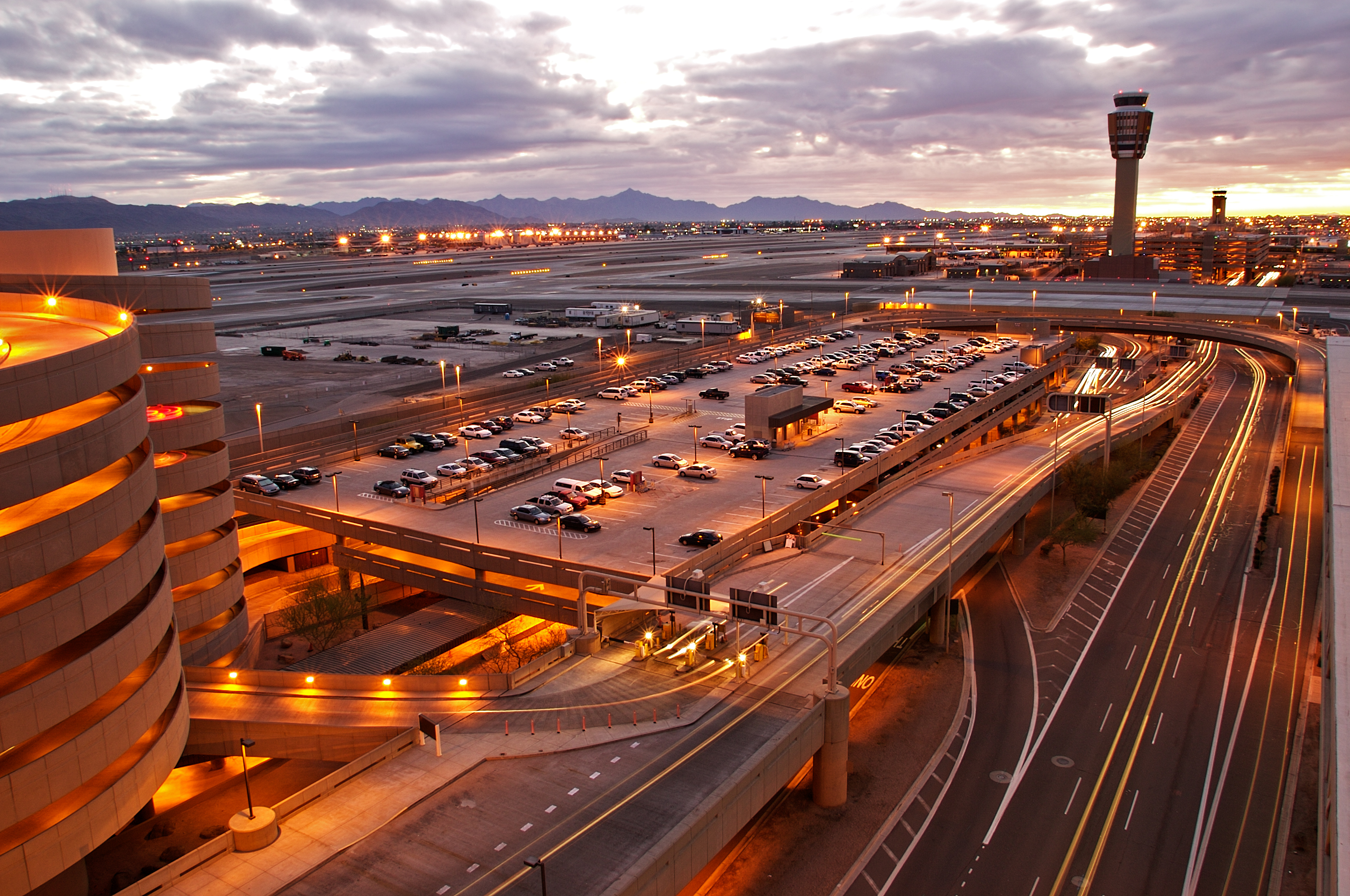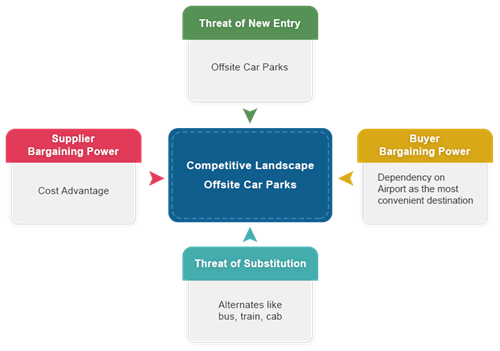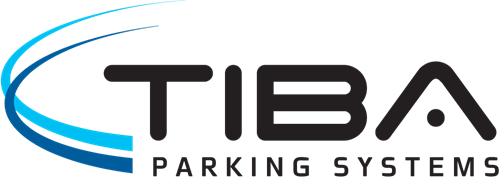
As an experienced airport car park revenue management professional, I appreciate that if managed, priced and distributed correctly, airport parking has the potential to add significant revenue to an airport’s bottom line.
Although ground transport process is only a by-product of the airlines’ and airports’ core businesses – the revenue potential certainly isn’t.
Let’s take a deeper look at the Market dynamics, through the Prism of Porter’s 5-force model.
- Threat of New Entry – Offsite car parks operated by 3rd parties are the most immediate pathway for new entrants in the market. They generally work by collecting customers cars at the airport in a short-stay facility, quickly moving them to more remote locations. Labor costs are primarily greeters and ‘jockeys’, usual rules of economies of scale apply. The problem that they face is of generating customer awareness and “traffic” to their parks. Reselling through an existing reseller/consolidator will involve paying high commission rates and convincing them of your viability/quality, direct marketing will incur high advertising/marketing costs plus overcoming the suspicion the public rightly have to new businesses with very little ‘trip-adviser’ type rating. Its relatively simple to create an off-site car park, persuading existing companies to sell it for you, for the public to use it is harder. And there is always the question of…’If that vacant land represents a demand-driven business opportunity, why are the existing suppliers at the airport not using it already?”
- Threat of Substitutes – Alternates to airport car parking include commute through coach, rail and cab, which increasingly means Uber in many markets. Accessibility to/from the major roadworks networks had a big influence on coach activity at an airport. In the UK, Heathrow is at the junction of the M25 and M4, close to the M3 and M40 and National Express have a comprehensive schedule, at other less accessible airports (admittedly smaller), coverage is far lighter. Many airports have a rail terminal, and to a point these are a viable option, but only for those travelling from the direction of the line, and multiple changes adds time and cost, especially when travelling with luggage or children.
Utilization of these modes depend on a combination of several factors including flight schedule, distance from airport, and passenger demographic profile (e.g. a single traveler pays the same to park as 4 in the same car, but the cost of public transport increases by group size). Likewise, the cost of a round train ticket to the station is broadly the same whether the passenger returns home tomorrow or next week, whereas the car parking cost increases with each passing day. Another factor is whether it is appropriate to tie up the “family car” at the airport if only one of the family is travelling. There is no doubt that for passengers travelling a short distance, or on someone else’s dime cabs are a convenient way to get to from the airport, but many, many people enjoy driving their own car and the ability to use it to get to/from the airport. The increasing availability of enhanced offerings like valet, electric charging and servicing all add to the value to the cash-rich, time-poor traveler and help counter the threat of substitutes.
- Buyer Bargaining Power – The airport’s own car parks generally command a price premium in the pre-booked market particularly the ones closest to the terminal. In the drive-up market, with no pre-booking the airports have almost a complete monopoly and this is generally the highest yielding sector, although the relative share of this sector decreases each year. Passengers of course have the option to use offsite car parks, but the convenience of a car park right at the airport is incomparable. However, where buyers do have considerable choice is which channel to purchase through. Both airport ‘official’ car parks and their competitors also sell through resellers/consolidators to whom the airport either provide a price discount or a commission. Either of these are revenue dilutionary to the airport. It is therefore incumbent on the airport to ensure that their direct channel ranks prominently in searches and that no unnecessary inventory is being sold through other channels. A revenue management system that trades off the demand through other channels against the lower yield they generate is invaluable to prevent excessive revenue leakage.
- Supplier Bargaining Power – Airports have a substantive advantage over their offsite competitors in that in almost all cases they own and have control over their own parking spaces. In the short term they are monetarizing space they already own, whereas in general their offsite competitors have a variable cost associated either with every car they park, or a commitment to lease premises. And while larger airports may need to operate shuttle buses etc., they will be able to use their purchasing power to do so at a rate their competitors will struggle to match. In the longer term the airport may wish to expand their capacity by e.g. converting surface to multi-story facilities. This has substantial cost, but the revenue management system, based on demand driven forecasts, is the only real tool to evaluate the return on investment from capita purchases. The ability of the revenue management solution to model ‘what-if’ analysis is often overlooked, but can be equally as important as the ongoing pricing evaluation.
The availability of high volume of target audience coupled with cost advantages makes airport car parking business a potentially high revenue, high profitability business with no stifling competition. I would like to mention here that maximizing pre-booked revenues for airport car parks requires optimal pricing for the car parks. This is where a product like GrayMatter’s Car Park Revenue Management (CPRM) comes in.
GrayMatter’s Car Park Revenue Management System (CPRM) is a demand-driven dynamic car park pricing & analytics system for car parks. CPRM not only recommends and applies optimal pricing but also provides critical data-driven insights to maximize revenue and management control, for both pre-bookings and drive-ups.
CPRM predicts and recommends future price every day for 90-365 days ahead based on historical data analytics, algorithms and business rules. Data visualization is done through dashboards and reports with various features and functionalities like Filters for Terminal, Car Park, Time period selection, Scorecards, Drill downs, etc.
About GrayMatter Software Services Pvt. Ltd.
GrayMatter Software is a Big Data, Data Science, Artificial Intelligence, IoT Data Integration.png) , BI and Analytics firm offering products and services in this space. GrayMatter’s Airport Analytics (AA+) product is a pre-built enterprise-wide solution for Airport Operators consisting of in-depth analytics for all areas of airports business by integrating data across 20+ airport systems into centralized data warehouse. Car Park Revenue Management (CPRM) is a part of the AA+ solution that optimizes car park occupancy and maximizes car park revenues. The solution provides price prediction as well as data-driven insights that maximize revenues and enhance management control.
, BI and Analytics firm offering products and services in this space. GrayMatter’s Airport Analytics (AA+) product is a pre-built enterprise-wide solution for Airport Operators consisting of in-depth analytics for all areas of airports business by integrating data across 20+ airport systems into centralized data warehouse. Car Park Revenue Management (CPRM) is a part of the AA+ solution that optimizes car park occupancy and maximizes car park revenues. The solution provides price prediction as well as data-driven insights that maximize revenues and enhance management control.



